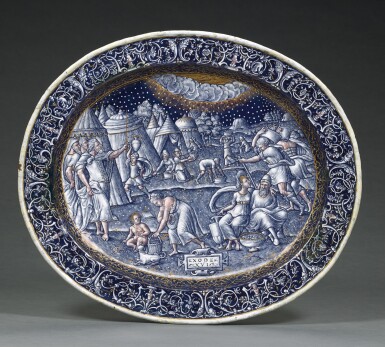BC/AD Sculpture Ancient to Modern
BC/AD Sculpture Ancient to Modern

ATTRIBUTED TO PIERRE REYMOND | OVAL DISH WITH THE MANNA FROM HEAVEN
Lot Closed
July 9, 03:03 PM GMT
Estimate
50,000 - 70,000 GBP
Lot Details
Description
ATTRIBUTED TO PIERRE REYMOND (1513-1584)
FRENCH, LIMOGES, CIRCA 1575-1580
OVAL DISH WITH THE MANNA FROM HEAVEN
inscribed: EXODE / XVI and with a painted number to the reverse: 81
painted enamel on copper, in a cloth-lined wood box
dish: 39.5 by 46cm., 15½ by 18⅛in.
box: 48 by 55 by 8cm.
Please note: Condition 11 of the Conditions of Business for Buyers (Online Only) is not applicable to this lot.
To view the Shipping Calculator, please click here
Private collection, United Kingdom
Although unsigned, the present dish can be confidently attributed to Pierre Reymond, one of the most prolific enamel painters in Limoges during the 16th century. Both the bowl of the dish, illustrating a scene from the Old Testament in blue-tinted grisaille, with highlighted flesh-tones, and the underside, showing the Goddess Diana surrounded by intricate Renaissance motifs, are very close to other oval dishes by Pierre Reymond, some of which are signed or initialled, and which are in the collections of some of the greatest public institutions in the world, such as the Hermitage and the Louvre. The present dish with the Manna from Heaven therefore forms an important addition to the master's oeuvre.
Throughout the 1570s, Pierre Reymond seems to have worked on a series of oval dishes depicting each a scene from the Old Testament on the interior, and a classical hero or deity on the reverse, set in a baldachin surrounded by a border with Renaissance motifs such as leaf garlands, sea monsters, grotesques and theatre masks. Since very little is known about Reymond's patrons or commissions, it is unclear whether these dishes were all part of a single commission, or made by Reymond and his workshop as commercial ware. Pierre Reymond had been producing copper plates and vessels in varying shades of grisaille enamel since 1540, and has even been credited with inventing these types of enamel objects (Caroselli, op. cit., p. 80). However, an oval dish with the Judgement of Moses, formerly part of the collection of M. Hubert de Givenchy (Kugel, op. cit., no. 7), which is perhaps the closest comparison to the present dish, also illustrating a scene from Exodus, bears the crest of the Chaspoux de Verneuil family, posing the tantalising possibility that the present dish was commissioned as part of a large service for that family.
Pierre Reymond's prolific career spanned over four decades: dated objects with his signature survive from between 1537 until 1578. As such, different styles and approaches can be seen in his work. While he frequently worked with polychromed enamel during his earlier years, his style turned more sombre in the 1560s and early 1570s, at which point usually the only colours on his enamels would be the rouge flesh tones and gold highlights. Around 1575, Pierre Reymond started using Etienne Delaune's engravings of classical heroes and gods, with elaborate borders with grotesques and floral arabesques, as is apparent on the present dish (Baratte, op. cit., p. 188). On Reymond's last known works, he seems to have returned to using some polychromy: for example on an oval dish, initialled PR, sold in these rooms, 8 July 2003, lot 97. The present dish can thus be tentatively dated to that last period of productivity of Pierre Reymond and his workshop, circa 1575-1580. The grisaille on the present dish is of a lustrous blue colour, showing a return to using polychromy, but must post-date 1575, as Delaune's engravings have been used as inspiration for the decoration on the underside of the dish.
An engraving of Diana by Etienne Delaune, holding the crescent moon in her outstretched left hand, and an arrow in the right hand, surrounded by borders with garlands and grotesques, is in the collection of the Rijksmuseum in Amsterdam (inv. no. RP-P-1964-4651). It most certainly served as the inspiration for the decoration of Diana on the present dish, although the sea monsters on either side of the goddess seem to have been lifted from a print of Juno (one such engraving is also in the Rijksmuseum, inv. no. RP-P-1964-2356). As such, the border decoration with grotesques is almost identical to the Judgement of Moses dish mentioned above (Kugel, op. cit., no 7) and further compares closely to the border decoration surrounding a figure of Minerva on a dish in the Louvre, signed PR and dated 1578 (inv. no. MR2419). Similarly to other oval dishes in the Old Testament series, the source for the composition of the central scene on the interior, depicting the Manna from Heaven, is a woodcut by Bernard Solomon, first published in the Quadrins Historiques de la Bible, Lyons, Jean de Tounes, 1553.
Pierre Reymond was a master in adapting print sources to the medium of beautifully enamelled copper, and the present dish is a prime example of such a work. With its sharply contoured and precise figures, the distinct salmon-pink flesh tones, and detailed shading with hatching and cross-hatching, it displays the notable characteristics of Pierre Reymond's late work. The attractive deep-blue background further distinguishes the present dish.
RELATED LITERATURE
S. Caroselli, The Painted Enamels of Limoges: A Catalogue of the Collection of the LACMA, cat. Los Angeles County Museum of Art, New York, 1993, pp. 80-83; 128-133; J. Kugel, Emaux de Limoges de la Renaissance, provenant de la collection de M. Hubert de Givenchy, Paris, 1994, no. 7, pp. 42-45; S. Baratte, Les Emaux peints de Limoges, cat. Musée du Louvre, Paris, 2000, pp. 187-188; 248-255
